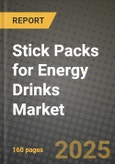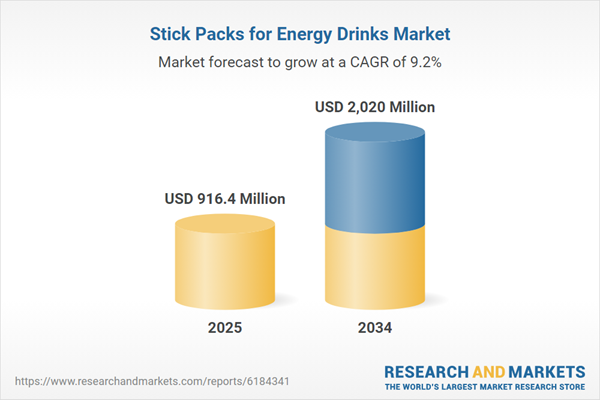Stick Packs for Energy Drinks Market
Stick packs for energy drinks sit at the intersection of convenience packaging and functional beverages, serving brands that want to offer portable, single-serve energy in powder form for dilution on the go. The format targets gym-goers, commuters, students, and travelers, as well as outdoor and esports communities seeking precise dosing, fast solubility, and minimal bulk. On the packaging side, multilayer laminates (typically PET/PE, BOPP/PE, or paper-based high-barrier alternatives) dominate, with rising adoption of mono-material and recyclable structures. Brands leverage stick packs for sampling, subscription kits, and e-commerce-optimized ship-in-own-container bundles, while retailers use them for impulse at checkout and club-size value packs. Key trends include sugar-free and clean-label formulations, natural caffeine sources (coffee fruit, green tea, yerba mate), hybrid benefits (energy + hydration/electrolytes + nootropics), and flavor rotation for seasonal drops. Drivers include on-the-go lifestyles, digital marketing economics that favor light, mailable packs, and retailer openness to space-efficient single-serves. The competitive landscape spans flexible packaging converters, film and coating suppliers, stick-pack machinery OEMs, co-packers/CMOs, and brand owners (including sports nutrition and pre-workout brands expanding into everyday energy). Differentiation increasingly comes from barrier performance, easy-tear and laser-score features, high-impact graphics (matte, metallic, tactile varnish), and rapid prototype-to-launch cycles. Compliance with caffeine disclosures, label claims, and packaging sustainability rules is central across major markets, with co-manufacturing partnerships and agile supply chains becoming a decisive advantage.Stick Packs for Energy Drinks Market Key Insights
- Format adoption and use cases: Stick packs win where portability, portion control, and hygiene matter - pre-workout warmups, endurance events, air travel, and desk-side consumption. The format also underpins brand sampling and trial, enabling low-risk flavor discovery and conversion to larger bundles through D2C and marketplaces. Retailers deploy them for cross-merchandising with water and shaker accessories, lifting basket size.
- Materials and barrier evolution: While foil-based laminates remain prevalent for moisture and aroma protection, brands are shifting toward high-barrier clear or metallized films and paper-based structures to align with recyclability goals. Mono-material PE/PP laminates, solvent-free adhesives, and drop-in AlOx/SiOx coatings are increasingly specified, balancing MVTR/OTR with easy-tear and seal reliability.
- Sustainability and compliance: Extended Producer Responsibility schemes and retailer recyclability scorecards push converters to reduce layers, inks, and overall packaging mass. Lifecycle trade-offs (lightweight sticks vs. multi-material recyclability) drive collaborative redesigns with film suppliers. Clear on-pack disposal guidance and QR-linked disclosures are becoming baseline for brand credibility.
- Product and formulation dynamics: Clean labels, natural caffeine sources, electrolyte blends, and adjuncts like L-theanine, B-vitamins, and adaptogens support broader day-time and cognitive-support occasions beyond sports. Micro-granulation and agglomeration techniques enhance cold-water solubility, reduce dusting, and improve mouthfeel - critical to repeat purchase.
- Channel architecture and economics: D2C subscriptions, Amazon multipacks, and club-store value bundles are the volume backbone, while gyms and specialty retail drive discovery. Stick packs are freight-efficient, enabling better contribution margins in parcel shipping. Brands use mixed-flavor “variety sticks” to de-risk new launches and smooth inventory.
- Operations and co-manufacturing: Speed to market hinges on co-packers with multi-lane stick lines, robust QA, and flexibility for frequent flavor changeovers. Digital or short-run flexo printing supports agile NPD, while automated counting/vision systems reduce miscounts and seal defects. MOQ discipline and qualified second sources mitigate supply shocks.
- Machinery and line design: Modern multi-lane VFFS stick packers offer higher speeds, servo control, and fast tool-less changeovers. Laser scoring, registered matte/gloss, and integrated code printing (lot/expiry/QR) are standard. Dose accuracy depends on powder flow, with auger or volumetric fillers tuned for hygroscopic blends and anti-caking regimes.
- Quality and risk management: Moisture ingress, aroma scalping, and pinholing remain key failure modes - addressed via barrier selection, seal window mapping, and transit testing. Counterfeit risk on marketplaces is countered with serialized QR, tamper-evident sachets, and first-party fulfillment. Stability studies underpin shelf-life claims across climates.
- Design and brand differentiation: Premium cues include soft-touch varnish, metallic highlights, and minimalistic flavor callouts. Easy-tear notches and mess-free spouts reduce user friction. Artwork systems are built for rapid flavor extensions, limited drops, and co-branded athlete/gamer editions, improving pace of innovation without re-engineering packs.
- Regulatory and age-gating context: Caffeine disclosures, claims substantiation, and retailer age-gating policies vary by market. Multilingual labeling and nutrition panels are table stakes for cross-border e-commerce. Brands increasingly align packaging claims (recyclable, plastic-reduction) with evolving regional rules to preserve shelf access and avoid relabeling.
Stick Packs for Energy Drinks Market Reginal Analysis
North America
Adoption is propelled by fitness culture, esports, and work-from-anywhere habits that favor portable, single-serve energy. D2C subscriptions and marketplace multipacks dominate, while convenience and club channels scale trial to repeat. Packaging priorities include cold-water solubility, strong moisture barriers, child-resistant secondary where appropriate, and recyclable claims aligned with retailer scorecards. Compliance focuses on caffeine disclosures and truthful structure/function claims. Co-manufacturing depth is strong, enabling quick flavor rotations and seasonal limited editions.Europe
Retailer scrutiny of caffeine messaging and sugar-reduction initiatives shape formulations and on-pack communication. Sustainability expectations are high: mono-material and paper-based high-barrier structures gain share, with recyclability labeling increasingly standardized. Private label sports nutrition players are expanding stick formats, and pharmacies/parapharmacies offer credible discovery channels. Brands optimize for multilingual packs, compact shelf footprints, and logistics to smaller, more frequent shipments. Paperization pilots and deposit-free flexible recovery schemes are closely watched.Asia-Pacific
Japan and South Korea have long familiarity with stick sachets across categories, easing energy-stick adoption in mainstream retail and vending. China and Southeast Asia see rapid uptake via cross-border e-commerce and influencer-led launches, with bright flavors and hybrid “energy + hydration” profiles. Packaging must handle humid climates and long supply chains; high-barrier laminates and silica integrations are common. Local co-pack capacity is expanding, while global brands rely on import partners and bonded warehouse fulfillment.Middle East & Africa
Growth is tied to expanding modern trade, gyms, and outdoor/sports tourism in GCC hubs. Heat and humidity drive stringent barrier requirements and transit robustness. Halal compliance and clear caffeine labeling are essential, with bilingual packs (Arabic/English) standard in the Gulf. Brands often begin with marketplace and specialty retail before expanding to supermarkets. Import reliance makes MOQ flexibility, shelf-life stability, and anti-counterfeit features (QR serialization) critical to protect brand equity.South & Central America
Fitness communities, convenience retail, and e-commerce are key entry points, with price sensitivity encouraging variety bundles and promotional multipacks. Packaging strategies balance barrier needs with simplified material stacks to manage duties and recycling narratives. Local regulations (labeling, claims) necessitate market-specific artwork, while regional co-packing partnerships shorten lead times. Flavor palettes skew tropical and citrus, with “energy + hydration” positioning resonating in warm climates and event-driven consumption.Stick Packs for Energy Drinks Market Segmentation
By Type
- Paper
- Foil
- Plastic
By Sales Channel
- Online
- Offline
Key Market players
Amcor, Constantia Flexibles, Huhtamaki, ProAmpac, Mondi, Sonoco Products Company, Berry Global, Winpak, Glenroy, Sealed Air, MSI Express, Sonic Packaging, The M Companies (THEM), National Packaging (NPCO), Grams Inc.Stick Packs for Energy Drinks Market Analytics
The report employs rigorous tools, including Porter’s Five Forces, value chain mapping, and scenario-based modelling, to assess supply-demand dynamics. Cross-sector influences from parent, derived, and substitute markets are evaluated to identify risks and opportunities. Trade and pricing analytics provide an up-to-date view of international flows, including leading exporters, importers, and regional price trends.Macroeconomic indicators, policy frameworks such as carbon pricing and energy security strategies, and evolving consumer behaviour are considered in forecasting scenarios. Recent deal flows, partnerships, and technology innovations are incorporated to assess their impact on future market performance.
Stick Packs for Energy Drinks Market Competitive Intelligence
The competitive landscape is mapped through proprietary frameworks, profiling leading companies with details on business models, product portfolios, financial performance, and strategic initiatives. Key developments such as mergers & acquisitions, technology collaborations, investment inflows, and regional expansions are analyzed for their competitive impact. The report also identifies emerging players and innovative startups contributing to market disruption.Regional insights highlight the most promising investment destinations, regulatory landscapes, and evolving partnerships across energy and industrial corridors.
Countries Covered
- North America - Stick Packs for Energy Drinks market data and outlook to 2034
- United States
- Canada
- Mexico
- Europe - Stick Packs for Energy Drinks market data and outlook to 2034
- Germany
- United Kingdom
- France
- Italy
- Spain
- BeNeLux
- Russia
- Sweden
- Asia-Pacific - Stick Packs for Energy Drinks market data and outlook to 2034
- China
- Japan
- India
- South Korea
- Australia
- Indonesia
- Malaysia
- Vietnam
- Middle East and Africa - Stick Packs for Energy Drinks market data and outlook to 2034
- Saudi Arabia
- South Africa
- Iran
- UAE
- Egypt
- South and Central America - Stick Packs for Energy Drinks market data and outlook to 2034
- Brazil
- Argentina
- Chile
- Peru
Research Methodology
This study combines primary inputs from industry experts across the Stick Packs for Energy Drinks value chain with secondary data from associations, government publications, trade databases, and company disclosures. Proprietary modeling techniques, including data triangulation, statistical correlation, and scenario planning, are applied to deliver reliable market sizing and forecasting.Key Questions Addressed
- What is the current and forecast market size of the Stick Packs for Energy Drinks industry at global, regional, and country levels?
- Which types, applications, and technologies present the highest growth potential?
- How are supply chains adapting to geopolitical and economic shocks?
- What role do policy frameworks, trade flows, and sustainability targets play in shaping demand?
- Who are the leading players, and how are their strategies evolving in the face of global uncertainty?
- Which regional “hotspots” and customer segments will outpace the market, and what go-to-market and partnership models best support entry and expansion?
- Where are the most investable opportunities - across technology roadmaps, sustainability-linked innovation, and M&A - and what is the best segment to invest over the next 3-5 years?
Your Key Takeaways from the Stick Packs for Energy Drinks Market Report
- Global Stick Packs for Energy Drinks market size and growth projections (CAGR), 2024-2034
- Impact of Russia-Ukraine, Israel-Palestine, and Hamas conflicts on Stick Packs for Energy Drinks trade, costs, and supply chains
- Stick Packs for Energy Drinks market size, share, and outlook across 5 regions and 27 countries, 2023-2034
- Stick Packs for Energy Drinks market size, CAGR, and market share of key products, applications, and end-user verticals, 2023-2034
- Short- and long-term Stick Packs for Energy Drinks market trends, drivers, restraints, and opportunities
- Porter’s Five Forces analysis, technological developments, and Stick Packs for Energy Drinks supply chain analysis
- Stick Packs for Energy Drinks trade analysis, Stick Packs for Energy Drinks market price analysis, and Stick Packs for Energy Drinks supply/demand dynamics
- Profiles of 5 leading companies - overview, key strategies, financials, and products
- Latest Stick Packs for Energy Drinks market news and developments
Additional Support
With the purchase of this report, you will receive:- An updated PDF report and an MS Excel data workbook containing all market tables and figures for easy analysis.
- 7-day post-sale analyst support for clarifications and in-scope supplementary data, ensuring the deliverable aligns precisely with your requirements.
- Complimentary report update to incorporate the latest available data and the impact of recent market developments.
This product will be delivered within 1-3 business days.
Table of Contents
Companies Mentioned
- Amcor
- Constantia Flexibles
- Huhtamaki
- ProAmpac
- Mondi
- Sonoco Products Company
- Berry Global
- Winpak
- Glenroy
- Sealed Air
- MSI Express
- Sonic Packaging
- The M Companies (THEM)
- National Packaging (NPCO)
- Grams Inc.
Table Information
| Report Attribute | Details |
|---|---|
| No. of Pages | 160 |
| Published | November 2025 |
| Forecast Period | 2025 - 2034 |
| Estimated Market Value ( USD | $ 916.4 Million |
| Forecasted Market Value ( USD | $ 2020 Million |
| Compound Annual Growth Rate | 9.2% |
| Regions Covered | Global |
| No. of Companies Mentioned | 15 |









